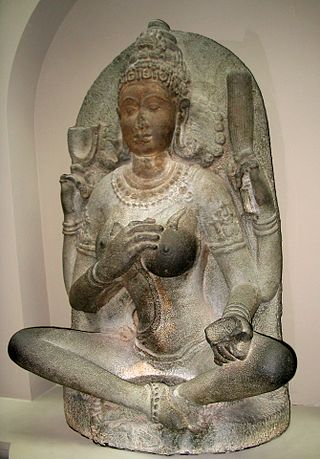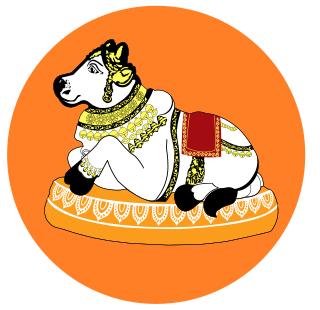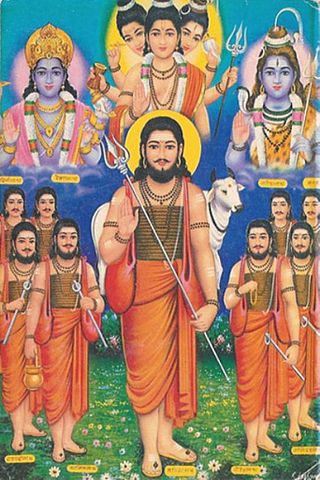
A yogi is a practitioner of Yoga, including a sannyasin or practitioner of meditation in Indian religions. The feminine form, sometimes used in English, is yogini.

Hatha yoga is a branch of yoga that uses physical techniques to try to preserve and channel vital force or energy. The Sanskrit word हठ haṭha literally means "force", alluding to a system of physical techniques. Some hatha yoga style techniques can be traced back at least to the 1st-century CE, in texts such as the Hindu Sanskrit epics and Buddhism's Pali canon. The oldest dated text so far found to describe hatha yoga, the 11th-century Amṛtasiddhi, comes from a tantric Buddhist milieu. The oldest texts to use the terminology of hatha are also Vajrayana Buddhist. Hindu hatha yoga texts appear from the 11th century onward.
In Sanskrit texts, Rāja yoga was both the goal of yoga and a method to attain it. The term also became a modern name for the practice of yoga in the 19th-century when Swami Vivekananda gave his interpretation of the Yoga Sutras of Patanjali in his book Raja Yoga. Since then, Rāja yoga has variously been called aṣṭāṅga yoga, royal yoga, royal union, sahaja marg, and classical yoga.

Siddha is a term that is used widely in Indian religions and culture. It means "one who is accomplished." It refers to perfected masters who have achieved a high degree of perfection of the intellect as well as liberation or enlightenment. In Jainism, the term is used to refer to the liberated souls. Siddha may also refer to one who has attained a siddhi, paranormal capabilities.
Avadhūta is a Sanskrit term from the root 'to shake' that, among its many uses, in some Indian religions indicates a type of mystic or saint who is beyond egoic-consciousness, duality and common worldly concerns and acts without consideration for standard social etiquette. Avadhūta is a Jivanmukta who gives his insight to others and teaches them about his realisation of the true nature of the ultimate reality (Brahman) and self (Ātman) and takes the role of a guru to show the path of moksha to others. Some Avadhūta also achieve the title of Paramahamsa.

Dattatreya, Dattā or Dattaguru, is a paradigmatic Sannyasi (monk) and one of the lords of yoga, venerated as a Hindu god. He is considered to be an avatar and combined form of the three Hindu gods Brahma, Vishnu, and Shiva, who are also collectively known as the Trimurti, and as the manifestation of Parabrahma, the supreme being, in texts such as the Bhagavata Purana, the Markandeya Purana, and the Brahmanda Purana, though stories about his birth and origin vary from text to text. Several Upanishads are dedicated to him, as are texts of the Vedanta-Yoga tradition in Hinduism. One of the most important texts of Hinduism, namely Avadhuta Gita is attributed to Dattatreya. Over time, Dattatreya has inspired many monastic movements in Shaivism, Vaishnavism, and Shaktism, particularly in the Deccan region of India, Maharashtra, Gujarat, Madhya Pradesh, Rajasthan and Himalayan regions where Shaivism is prevalent. His pursuit of simple life, kindness to all, sharing of his knowledge and the meaning of life during his travels is reverentially mentioned in the poems by Tukaram, a saint-poet of the Bhakti movement.

The Haṭha Yoga Pradīpikā is a classic fifteenth-century Sanskrit manual on haṭha yoga, written by Svātmārāma, who connects the teaching's lineage to Matsyendranath of the Nathas. It is among the most influential surviving texts on haṭha yoga, being one of the three classic texts alongside the Gheranda Samhita and the Shiva Samhita.

Sahaja means spontaneous enlightenment in Indian and Tibetan Buddhist spirituality. Sahaja practices first arose in Bengal during the 8th century among yogis called Sahajiya siddhas.

A matha, also written as math, muth, mutth, mutt, or mut, is a Sanskrit word that means 'institute or college', and it also refers to a monastery in Hinduism. An alternative term for such a monastery is adheenam. The earliest epigraphical evidence for mathas related to Hindu-temples comes from the 7th to 10th century CE.

Matsyendranātha, also known as Matsyendra, Macchindranāth, Mīnanātha and Minapa was a saint and yogi in a number of Buddhist and Hindu traditions. He is considered the revivalist of hatha yoga as well as the author of some of its earliest texts. He is also seen as the founder of the natha sampradaya, having received the teachings from Shiva. He is associated with Kaula Shaivism. He is also one of the eighty-four mahasiddhas and considered the guru of Gorakshanath, another known figure in early hatha yoga. He is revered by both Hindus and Buddhists and is sometimes regarded as an incarnation of Avalokiteśvara.

A yogini is a female master practitioner of tantra and yoga, as well as a formal term of respect for female Hindu or Buddhist spiritual teachers in the Indian subcontinent, Southeast Asia and Greater Tibet. The term is the feminine Sanskrit word of the masculine yogi, while the term "yogin" IPA:[ˈjoːɡɪn] is used in neutral, masculine or feminine sense.

Gorakhnath was a Hindu yogi, saint who was the founder of the Nath Hindu monastic movement in India. He is considered one of the two disciples of Matsyendranath. His followers are known as Jogi, Gorakhnathi, Darshani or Kanphata.
The Adinath Sampradaya was a sadhu sub-sect of the greater Nath tradition. Followers of this tradition were given Sannyasa diksha, thus renouncing householder life, and thereafter lived as naked sadhus. Believing that sadhus should live alone until they had attained the goal, they lived in caves, huts, ruined buildings, or empty houses, and always away from towns and villages. Reference to the Adinath Sampradaya is pointed out by Rajmohan Nath (1964) who lists them among the twelve traditional sub-sects of the Nath Sampradaya. The Adinath Sampradaya is also listed among the sub-divisions of Nath sects in the Census Report, Punjab, 1891, p. 114. The last sadhu holding authentic guru status in the Adinath Sampradaya was Shri Gurudev Mahendranath, who died in 1991. Though he created, and gave Diksha into, a western householder variant of the Nath Tradition, he intentionally terminated the Adinath Sampradaya by refusing to bestow sannyasa diksha, an initiation required for succession. The Sanskrit term Adi Nath means "first" or "original Lord," and is therefore a synonym for Shiva and, beyond mental concepts, the "Supreme Reality" as originator of all things. G.W. Briggs noted, "although Adinath may have been a yogi preceding Matsyendranath, he is now identified with Shiva, and the name is used to trace the origin of the (Nath) sect to the greatest of yogis, the god Shiva".
ALAKH NIRANJAN is a term used by Nath Yogis as a synonym for Creator, and to describe the characteristics of God and the Self, known as the Atman. ALAKH means "The one who can't be perceived" and NIRANJAN means "The one who is colourless".
The Shri Guru Charitra is a book based on the life of Shri Nrusimha Saraswati, written by the 15th-16th century poet Shri Saraswati Gangadhar.

The Navnath, also spelt as Navnatha in vernacular languages, are the nine saints, Masters or Naths on whom the Navnath Sampradaya, the lineage of the nine gurus, is based. They are worshipped collectively as well as individually.
Yogi Nath is a Shaivism-related group of monks which emerged around the 13th-century. They are sometimes called Jogi or simply Yogi, and are known for a variety of siddha yoga practices.

The Inchagiri Sampradaya, also known as Nimbargi Sampradaya, is a lineage of Hindu Navnath and Lingayat teachers from Maharashtra and Karnataka, which was started by Bhausaheb Maharaj. It is inspired by Sant Mat teachers as Namdev, Raidas and Kabir. The Inchagiri Sampradaya has become well known throughout the western world due to the popularity of Nisargadatta Maharaj.
David Gordon White is an American Indologist and author on the history of yoga and tantra. He won the CHOICE book selection in religion, and an honorable mention in the PROSE book awards, both for Sinister Yogis.

The Amaraugha and the Amaraugha Prabodha are recensions of a 12th century Sanskrit text on haṭha yoga, attributed to Gorakṣanātha. The Amaraugha Prabodha is the later recension, with the addition of verses from other texts and assorted other materials. The text's physical practices imply a Buddhist origin for haṭha yoga.


























